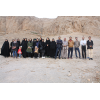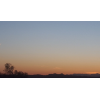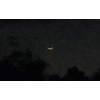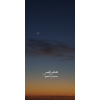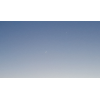Visibility of Sha'ban Crescent 1439 AH
- When to Observe Sha'ban Waxing (NEW) Crescent ?
- Sha'ban Waxing (NEW) Crescent Observation Results
- The OFFICIAL First Day in Different Countries
- When to Observe Rajab Waning (OLD) Crescent ?
- Rajab Waning (OLD) Crescent Observation Results
When to Observe Sha'ban Waxing (NEW) Crescent ?
The geocentric conjunction (Geocentric New Moon) will occur Inshalla on (Monday 16 April 2018) at 01:57 UT.
Sighting the new crescent on (Monday 16 April 2018) and (Tuesday 17 April 2018) is shown in the below graphs using the program Accurate Times by Mohammad Odeh according to Odeh criterion. Where:-
- It is impossible to see the crescent from the areas located under the red color. Because either the Moon on this day sets before the Sunset and/or the topocentric conjunction occurs after the Sunset.
- The crescent is expected to be seen by optical aid only from the areas located under the blue color.
- The crescent is expected to be seen by optical aid from the areas located under the magenta color. In these areas the crescent could be seen by naked eye if the atmospheric conditions are superb and the observer is experienced.
- The crescent is expected to be easily visible by naked eye from the areas located under the green color.
- The crescent cannot be seen from uncolored areas, even though the Moon sets in these locations after the Sunset and the topocentric conjunction occurs before the Sunset, but the Moon is not sufficiently illuminated in order to be seen as crescent even by optical aid.
- Kindly notice that the below graph shows the possibility of seeing the crescent from areas between 60 degrees north of Equator down to 60 degrees south of Equator.
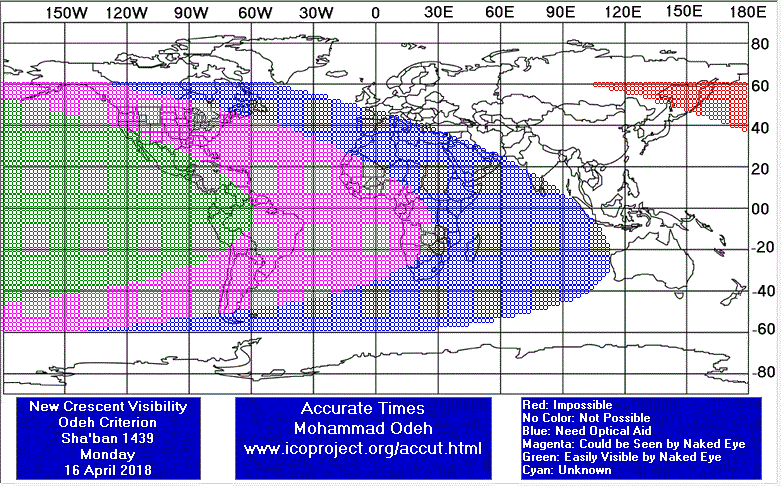

According to the Universal Hejric Calendar (UHC), which is based on the calculated crescent visibility, the start of this month in the Eastern Region will be on Tuesday 17 April 2018 and in the Western Region will be on Tuesday 17 April 2018. Kindly notice that the UHC is a pre-calculated calendar, which adopts a certain criterion to start the new Hejric month. Your country/organization might adopt different criterion to start the new Hejric month. So it is highly advised to read the UHC website before giving any judgment.
- Results of seeing the crescent, and the first day of the month in different countries will be added here Inshalla as we receive the reports from ICOP's members. If you wish to be a member in ICOP, or to know more about it, kindly click here.
Sha'ban Waxing (NEW) Crescent Observation Results
Mon 16 April 2018
Australia
Indonesia
Mr. AR Sugeng Riyadi said: "The Hilal of Shaban 1439 AH was NOT SIGHTED on Monday, April 16th, 2018 from Sukuh Hill Karanganyar Central Java Indonesia. The west horizon was hazy and the hilal position covered by thick clouds. This event was attended by Team of Assalaam Observatory, Ministry Religious Affairs Leader of Karanganyar District, Team of Gara -Syariah Ministry of Religious Affairs of Karanganyar, LFNU of Madiun and more than 100 moslem, and Team of CASA, Solo Astro Club and Rowasiya Obs. According to the The Ministry of Religious Affairs Calendar, the first of Shaban 1439 A.H in Indonesia starts on Tuesday, April 17th, 2018."
Iran
Mr. Hossein Janghorbani said: "Mr.Reza Janghorbani based in the city of Tabriz in East Azerbaijan province due to hazy weather, Not see the crescent moon."
Mr. Hossein Janghorbani said: "In the name of God Happy new Years (Jalali Hosseini 14397 - In accordance with Serolaajaeb calendar, The Astronomy and Geophysics Center of Shahreza- Hossein Janghorbani) Sha'ban Crescent Observation Report The Astronomy and Geophysics Center of Shahreza – The Crescent Association of Shahreza Report by: Hossein Janghorbani (Najmosepehr-Sadrolmonajjemin) – Manager of Shahreza Crescent Association and Red Crescent’s Astronomy and Geophysics Center Date: Monday, 04/16/2018 Location: Damzad foothills in the East of Shahreza (latitude: 32 00 N, longitude: 51 52 E, elevation: 1825m from sea level, time zone: +4.5 GMT) Equipments: Two sets of 15*70 binoculars, One compass. Atmospheric condition: partly cloudy. Horizon obstacles: 2.5° Apparent sunset: --:-- Results: Moon crescent was not seen by naked eye, Moon crescent was not seen by binocular. Observers: 1.Mohammad Reza Kazemi 2.EhsanAli Alinezhad 3.Mohammad Reza Hadad 4.Mohammad Hossein Heydari 5.Mohammad Sam Eghbal 6.Ali Janghorbani 7.Hossein Janghorbani 8.Mahnaz Arami 9.Mohadeseh Alinezhad 10.Misagh Alinezhad 11.Ezat Nazariat 12.Parisa Ghadimi 13.Shahideh Torabi 14.Hakimeh Ghermezi 15.Roya Ghermezi 16.Zinat Ghermezi 17.Ziba Hafar 18.Maryam Shahcheraghi 19.Shideh Pooya 20.Maryam Same 21.Mahtab Bahrami 22.Shahnaz Soroori 23.Zahra Fallahi "
Morocco
Mr. Abdessamad Doukkane said: "راقبت مندوبية الأوقاف والشؤون الإسلامية بالناضور هلال شعبان بمشاركة جمعية المبادرة المغربية للعلوم والفكر ولم تثبت رؤيته. في انتظار قرار وزارة الأوقاف والشؤون الاسلامية"
Nigeria
Dr. Usman El-Nafaty said: "The sky was partly cloudy here in Bauchi. The crescent of Sha’baan 1439H was not sighted"
Saudi Arabia
Mr. Turki Alamri said: "I had a clear sky with Aod 0.15 for 500 But I couldn’t see it with binoculars neither by naked eye . I didn’t use my telescope and my imaging system due to telescope issues."
United States
Dr. Javad Torabinejad said: "I arrived at my first sighting location in Blacksburg at 8:04 pm EDT (sunset: 7:58 pm). Soon, using a pair of binoculars (7X50), I started scanning clearings in a mostly cloudy and hazy western horizon; I stayed there for about 14 minutes. I left for my second sighting location in Christiansburg (Lat: 37° 7' 48" N, Lng: 80° 24' 32" W, and elevation: 638 meters), hoping that the crescent would appear in the clearings there. Again, I looked for another 14 minutes till 8:41 pm with no success (moonset: 8:45 pm)."
Tue 17 April 2018
Germany
Indonesia
Mr. AR Sugeng Riyadi said: "The new crescent of Sha'ban 1439 AH was not seen on Tuesday, April 17, 2018 from Rowasiya Observatory, Bendo Ketitang Juwiring Klaten Central Java Indonesia. The sky was cloudy. The hilal was sighted from Al-Buruj Observatory, Kudus by mr. Joko Prasetyo, from Subang West Java and from Lhokseumawe Aceh North Sumatera by mr. Isma'il. "
Morocco
Nigeria
Dr. Usman El-Nafaty said: "The weather was partly cloudy but the crescent of Sha’abaan 1439H could be seen behind the clouds. Alhamdu Lillah."
The OFFICIAL First Day in Different Countries
Tue 17 April 2018
1 . Algeria
2 . Bahrain
3 . Egypt
4 . Indonesia
5 . Iraq
6 . Jordan
7 . Kuwait
8 . Libya
9 . Oman
10 . Palestine
11 . Qatar
12 . Saudi Arabia
13 . Sudan
14 . Syria
15 . Tunisia
16 . Turkey
17 . United Arab Emirates
18 . Yemen
Wed 18 April 2018
1 . Australia
2 . Iran
3 . Morocco
4 . Nigeria
5 . Pakistan
When to Observe Rajab Waning (OLD) Crescent ?
The geocentric conjunction (Geocentric New Moon) will occur Inshalla on (Monday 16 April 2018) at 01:57 UT.
Sighting the OLD crescent on (Monday 16 April 2018) and (Sunday 15 April 2018) is shown in the below graphs using the program Accurate Times by Mohammad Odeh according to Odeh criterion. Where:-
- It is impossible to see the OLD crescent from the areas located under the red color. Because either the Moon on this day rises after the Sunrise and/or the topocentric conjunction occurs before the Sunrise.
- The crescent is expected to be seen by optical aid only from the areas located under the blue color.
- The crescent is expected to be seen by optical aid from the areas located under the magenta color. In these areas the crescent could be seen by naked eye if the atmospheric conditions are superb and the observer is experienced.
- The crescent is expected to be easily visible by naked eye from the areas located under the green color.
- The crescent cannot be seen from uncolored areas, even though the Moon rises in these locations before the Sunrise and the topocentric conjunction occurs after the Sunrise, but the Moon is not sufficiently illuminated in order to be seen as crescent even by optical aid.
- Kindly notice that the below graph shows the possibility of seeing the crescent from areas between 60 degrees north of Equator down to 60 degrees south of Equator.

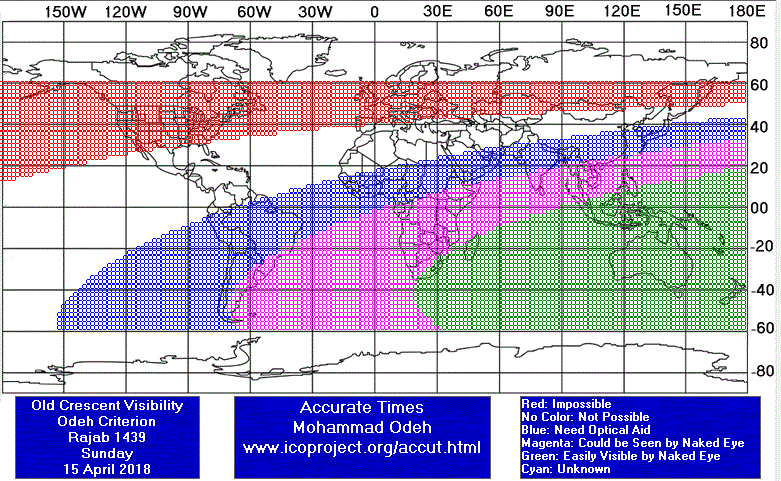
Rajab Waning (OLD) Crescent Observation Results
Sat 14 April 2018
Indonesia
Mr. AR Sugeng Riyadi said: "The old crescent of Rajab 1439 AH was seen on Saturday, 14 April 2018 from Rowasiya Observatory, Bendo Ketitang Juwiring Klaten Central Java Indonesia. The sky was clear."







